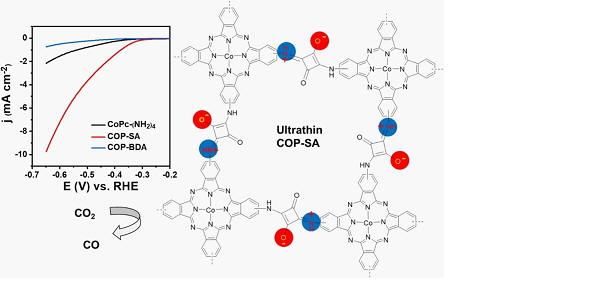Zwitterionic ultrathin covalent organic polymers for high-performance electrocatalytic carbon dioxide reduction

Published on Applied Catalysis B: Environmental (21 November 2020)
Author(s): Yun Song, Jun-Jie Zhang, Zhaohua Zhu, Xin Chen, Libei Huang, Jianjun Su, Zhengtao Xu, Thuc Hue Ly, Chun-Sing Lee, Boris I. Yakobson, Ben Zhong Tang, Ruquan Ye*
Abstract
Covalent organic polymers (COPs) or covalent organic frameworks (COFs) are emerging types of electrode materials for electrochemical CO2 reduction reaction (CO2RR) owing to their controllable structures at the molecular level. However, their activities are often limited by stacking structures and low conductivities. Here we report an ultrathin cobalt tetraamino phthalocyanine-squaraine based COPs (COP-SA) for high-performance CO2RR towards CO. The extended π-conjugated skeleton constitutes the layer, and the zwitterionic structure from the squaraine unit helps the dispersion of layers, leading to an ultrathin thickness of ∼1.7 nm. The ultrathin nanostructure avoids the common agglomeration issues for molecular catalysts and thick nanomaterials, which is beneficial to afford highly exposed active sites and efficient electron transfer for electrochemical reactions. Theoretical calculation suggests that the squaraine unit will enhance the COOH adsorption and favor the CO desorption. These collectively conduce to a high current density of 9.74 mA cm−2 with 96.5 % CO faradaic efficiency, a large turnover frequency of 46 s-1 (by total cobalt site) at -0.65 V vs RHE and excellent cycling stability. This work underscores the structural and electronic effects for the rational design of ultrathin COPs materials for electrochemical CO2RR.

Read more: https://doi.org/10.1016/j.apcatb.2020.119750